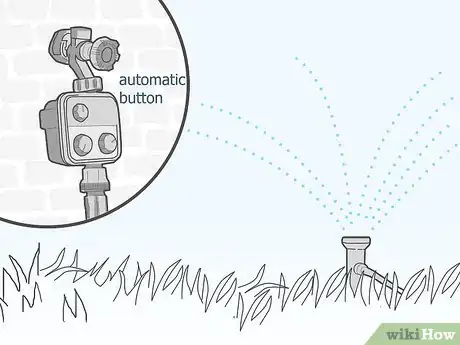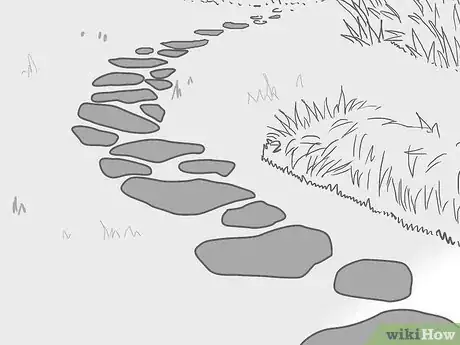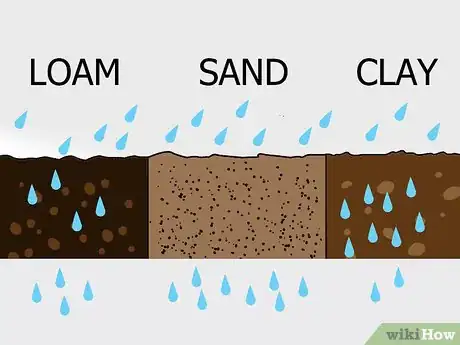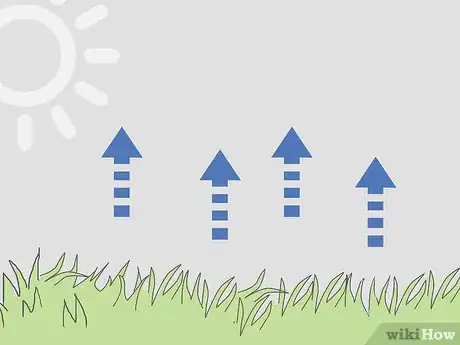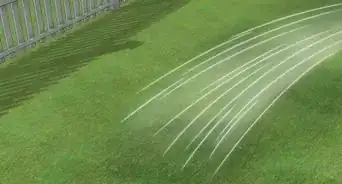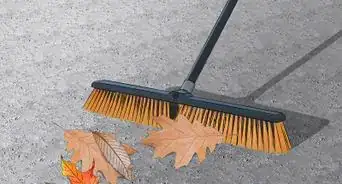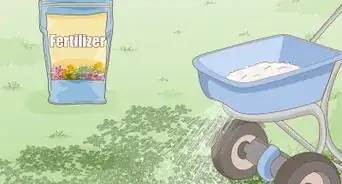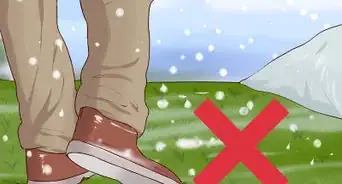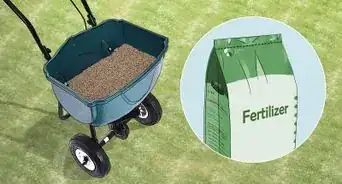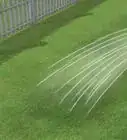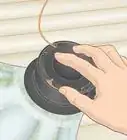This article was co-authored by Jeremy Yamaguchi. Jeremy Yamaguchi is a Lawn Care Specialist and the Founder/CEO of Lawn Love, a digital marketplace for lawn care and gardening services. Jeremy provides instant satellite quotes and can coordinate service from a smartphone or web browser. The company has raised funding from notable investors like Y Combinator, Joe Montana, Alexis Ohanian, Barbara Corcoran and others.
There are 11 references cited in this article, which can be found at the bottom of the page.
wikiHow marks an article as reader-approved once it receives enough positive feedback. In this case, 90% of readers who voted found the article helpful, earning it our reader-approved status.
This article has been viewed 1,329,275 times.
For many homeowners, a lush green lawn is a symbol of pride and a pleasant place to relax or play. But maintaining a green lawn will require a lot of water, and depending on where you live, there may be water restrictions or simply low water levels for much of the year. No matter where you live, it's important to learn ways to conserve as much water as possible. Learning how to efficiently water your lawn will help save you money and preserve this precious natural resource.
Steps
Finding Ways to Conserve Water
-
1Adjust your mowing habits. Mowing the lawn is essential, but mowing too often or cutting the grass too low can dry out an otherwise healthy lawn. Using the same pattern to mow your lawn can also cause stress to the grass from the repeated wheel tracks that follow the same direction week after week.
- Try changing the direction(s) you mow in every time you cut the grass. It will help cut down on stress to the lawn, and may also prevent divots from forming in your pattern.
- Set your mower's wheels to the proper height. There is some variance of recommended heights depending on the type of grass in your yard. Tall Fescue grass, for example, should be kept no shorter than two and a half to three inches, while Bermuda grass should be kept between ¾ of an inch and 1½ inches.
-
2Use a smart clock. If you have an automatic irrigation system, you may want to consider getting a smart clock or smart irrigation controller. These devices regulate how much water is put out by your sprinkler system and typically have some type of rain sensor, which automatically shuts off your sprinklers when it starts to rain.
- Some state or regional authorities offer rebates or tax incentives for water consumers who install smart irrigation systems. Check with your local water authority to see if you would qualify for such a program.
Advertisement -
3Reduce how much you fertilize. Frequent fertilization of your yard may dry out the lawn. Using too much fertilizer or fertilizing too often will increase the need to water your lawn more frequently and in greater quantities.[1]
- In late spring and early fall, use a fertilizer that is three parts nitrogen, one part phosphorus, and two parts potassium. This is ideal for maintaining a healthy lawn without needing to over water the grass.[2]
- Opt for either slow-release fertilizer or a mixture of quick- and slow-release fertilizers for your lawn. Quick-release fertilizer releases all of the nitrogen rapidly, which will require more frequent applications over time.[3]
- Follow the instructions and recommendations on your fertilizer's packaging label, or read online about how and when to properly apply fertilizer to your lawn.[4]
-
4Consider reducing unnecessary watering. Watering your lawn serves a number of purposes. In addition to keeping the grass at its optimum health, it also reduces airborne dust and helps regulate the temperature of the soil. But if there are parts of your yard that do not get a lot of foot traffic or do not serve an aesthetic purpose (parts of the backyard or side yard, for example), consider reducing how much and how often you water those areas. You can still water them regularly to prevent withering, but they may not need as much water as the rest of the yard.[5]
- In addition to cutting back on which parts of the lawn you water, you can also reduce evaporation around certain plants or flowerbeds by laying down a layer of organic mulch over the topsoil. This will help conserve water, and may reduce how often you need to water these parts of your yard.
-
5Recycle water. If you're watering your grass and not a vegetable or fruit garden, you may want to consider recycling water. Rainwater is safe to use, as it is the same water that would otherwise naturally irrigate your yard, though there may be restrictions on how rainwater is collected and harvested depending on where you live.[6] Grey water, the gently-used and non-hazardous water from showers, dish sinks, and washing machine runoff, is not safe to drink but is generally considered safe to use for watering your lawn.[7]
- If harvesting grey water, be sure to use environmentally-safe soaps and detergents. Try to use products that are considered "plant friendly," meaning they are free from salt, boron, and chlorine bleach.[8]
- Try collecting rainwater. It's safe to use on any part of your lawn (including vegetable gardens), and it helps cut down on municipal water consumption. Some states in the U.S. have their own laws about the collection and use of rainwater. To find out any requirements or restrictions on collecting and using rainwater in your state, check the American Rainwater Catchment Systems Association website, click the Resources tab, and read the section titled Laws, Rules & Codes.[9]
- An easy way to get started collecting rainwater is to simply arrange buckets or barrels under the downspout coming off your gutter. If you decide that collecting rainwater is something you'd like to pursue more actively, there are more advanced collection methods, like rain barrels.
-
6Check for leaky sprinklers. Broken or leaky sprinklers waste a substantial amount of water, and may actually be overwatering parts of your lawn. To cut back on your water bill and conserve water during times of drought, it's important to check your sprinkler system and water faucets and fix or replace any leaky or broken hardware.
Altering Your Lawn to Conserve Water
-
1Pull weeds frequently. Weeds not only take up space in your yard, they also compete for water and nutrients in the soil. When you pull up weeds, be sure that you dig deep enough to remove the entire root system, as pulling out the surface sprouts will not effectively kill the weed.[10]
- If you must use chemical herbicides on your weeds, use spot applications instead of a broad, whole-yard application. Spraying the entire yard can harm many of the organisms that live in the soil and could potentially pollute your local groundwater system.[11]
-
2Choose the right grass. While it may seem to the untrained eye that grass is simply grass, there are, in fact, many different types of grass. Each variety has its own advantages, depending on the climate and region in which you live.[12]
- Perennial Ryegrass is somewhat drought tolerant, easy to establish across the lawn, and can compete well with weeds that sprout up in the yard.[13]
- Tall Fescue grass is very drought tolerant and has the deepest root system of all turf grasses, running anywhere from three to six feet deep. Tall Fescue doesn't necessarily use less water, but it does use water the same way a deep-root plant would use water. It also stays green during drought, which is advantageous if you live in a drought-prone climate.[14]
- Fine Fescue grass has a low fertilizer requirement and a high drought tolerance. It can actually go dormant during dry periods when water is absent, and will quickly come back to a healthy shade of green once water is returns.[15]
- Bentgrass grows well during cool weather, and much like Fine Fescue it can also go dormant during droughts. Bentgrass does not require very much fertilizer, either.[16]
- Kentucky Bluegrass grows best in cool, humid, semi-arid, and temperate climates. This grass variety is moderately drought-tolerant.[17]
-
3Consider alternatives to turf. Whether you have a large yard that is difficult to manage or you simply want a little more diversity in your yard's landscape, there are plenty of options for non-turf alternatives. Some drought-stricken communities may even offer incentives to homeowners who opt for non-turf alternatives, so it may be worth checking online or with your local department of natural resources to see if your region offers these incentives.
- Ground cover makes a fine substitute for turf in some yards. Ground cover, like drought-resistant plants, are ideal for low-traffic parts of the yard. Planting ground cover in slanted parts of the yard that tend to lose a lot of water may also help conserve some water and promote a greener yard.[18]
- Perennials, shrubs, and trees are all excellent alternatives to grass. Many of these plants have drought-resistant varieties that can help control erosion and water loss.[19]
- Hardscapes, like decking or pavement (including stepping stones), can help cut back on how much you need to water your yard. Hardscapes also create recreation space, as a deck or patio makes an excellent place to sit outside for picnics, meals, or simple downtime.[20]
Identifying the Ideal Amount of Water for Your Lawn
-
1Evaluate your soil type. The type of soil under your lawn, as well as the climate and time of year, will dictate how often you need to water your lawn. If you live in an area that is prone to heavy rainfall during parts of the year, for example, you will not need to water as frequently. Certain yards may not reap the full benefits of rainfall, however, depending on the yard's composition and layout.[21]
- Certain soil types absorb water better than others. A high composition of clay, for example, will prevent water from absorbing into the soil.[22]
- Clay tends to retain an average around 1.5 inches of water per foot of soil, while fine sand and loamy sand retain the least amount of water at 0.7 and 0.8 inches of water per foot of soil, respectively.[23]
- Silty loam, clay loam, and silty clay loam have the highest water retention of all soil types, averaging 2.4 inches of water per foot of soil.[24]
- The layout of the yard is a factor as well. A sloped lawn will not be able to absorb much excess water. Any moisture not readily absorbed will most likely run off downhill.[25]
-
2Decide when to water. Certain times of day are better than others when watering your lawn. Timing will also vary depending on your climate. It may come as no surprise that where you live may be the biggest factor in when and how often you need to water your lawn.
- If you live in a humid climate, you should water your lawn between 10:00 PM and 6:00 AM for optimum results.[26]
- In hot, arid climates, it's best to water lawns in the still hours of the early morning, before sunrise. This will help reduce the amount of water that would otherwise be lost to daytime evaporation and winds.
- In cooler temperatures, it's best to water your lawn before 10:00 AM or after 6:00 PM. This will minimize evaporation.[27]
EXPERT TIPJeremy Yamaguchi is a Lawn Care Specialist and the Founder/CEO of Lawn Love, a digital marketplace for lawn care and gardening services. Jeremy provides instant satellite quotes and can coordinate service from a smartphone or web browser. The company has raised funding from notable investors like Y Combinator, Joe Montana, Alexis Ohanian, Barbara Corcoran and others.Lawn Care Specialist
 Jeremy Yamaguchi
Jeremy Yamaguchi
Lawn Care SpecialistSet and maintain a consistent schedule. A set, twice-weekly schedule can keep you on track. If you keep your waterings deep and infrequent, you'll keep your lawn healthier and conserve water.
-
3Determine how often to water. While some may feel that the lawn should be watered on a daily basis, oftentimes this is not necessary. Many factors influence how often you need to water your lawn. In drought-prone Southern California, for example, you may need to water your lawn anywhere from 20 minutes per week to 200 minutes per week, depending on the region, time of year, and hourly sprinkler output.[28]
- Use the minimum amount of water necessary to maintain your lawn. Using too much water will run up your monthly water bill, waste vital resources, and may end up damaging your lawn with over-saturation.[29]
- The best measure for determining how often to water your lawn is to check the lawn itself. If footprints or lawnmower tracks remain indented in the grass for longer than 30 minutes after passing through your yard, it is a good sign that your grass is getting dry.[30]
- Check the color of your lawn. Turf grass that is dry will often turn to a blueish-gray shade, rather than a lush green.[31]
- You can also check the soil moisture to see if your lawn needs to be watered. Drive a six-inch screwdriver or stake into the ground. If the screwdriver breaks through the soil easily and without much effort, the soil is likely retaining enough water and you can hold off on watering.[32]
-
4Measure your sprinkler output. One important factor in determining how often to water your lawn is how much water your sprinkler system puts out. You can measure the output of your sprinklers by arranging empty and cleaned tuna cans or cat food cans across your lawn. If you do not have empty cans, several coffee mugs will also work well. Then run the sprinklers for 20 minutes and use a ruler to measure the water depth across the yard.
- After 20 minutes, add all the depths together from each container in your yard and divide by the total number of containers to obtain an average for the whole yard. Then multiply that number (the total yard measurements over 20 minutes) by three to average your total sprinkler output per hour (60 minutes).[33]
- Compare your yard's sprinkler output with your region's recommended monthly watering time. You can find a chart for your region by searching online.
-
5Calculate the exact amount of water optimal for your lawn. Each lawn will have its own ideal amount of water necessary for its grass to grow and thrive. This amount depends on factors like the kind of grass growing, soil composition, climate, and so on. You'll need to replenish water that leaves your lawn to keep it healthy, which is best determined by the evapo-transpiration rate (ET).[34]
- The process of calculating the ET can be complex for some. For a complete explanation on how to find the ET, visit the United Nations Food and Agriculture Organization's (FAO) page on calculating it.[35]
- To make the process of calculating the ET easier for laypeople, the FAO provides ET free calculators on their site.[36]
- If you've exhausted your wits trying to figure out the ET for your lawn, you may want to inquire about it with a master gardener at your local nursery or greenhouse.
Expert Q&A
Did you know you can get expert answers for this article?
Unlock expert answers by supporting wikiHow
-
QuestionHow many days a week should you water your lawn?
 Maggie MoranMaggie Moran is a Professional Gardener in Pennsylvania.
Maggie MoranMaggie Moran is a Professional Gardener in Pennsylvania.
Home & Garden Specialist
-
QuestionCan you water your lawn in the sun?
 Maggie MoranMaggie Moran is a Professional Gardener in Pennsylvania.
Maggie MoranMaggie Moran is a Professional Gardener in Pennsylvania.
Home & Garden Specialist
-
QuestionIs it bad to water the lawn in the evening?
 Maggie MoranMaggie Moran is a Professional Gardener in Pennsylvania.
Maggie MoranMaggie Moran is a Professional Gardener in Pennsylvania.
Home & Garden Specialist
Warnings
- Find out if your community has watering restrictions. Many communities have responded to water shortages by implementing laws that restrict how many times per week residents can water their lawns, or for how long, and/or at what times. If you live in such an area, this article can still help you, but be sure to abide by the restrictions.⧼thumbs_response⧽
- Be sure to check local ordinances before creating a rain barrel. In some places it is illegal, or there may be restrictions on how much water can be collected and through what methods. This is often due to water rights laws, which allocate all fresh water in rivers and streams, including the runoff into a river from rainfall, to a hierarchy of water rights owners.⧼thumbs_response⧽
- If you choose to use a pesticide or herbicide to get a lush lawn, be very care and judicious in your use, as overuse can negatively impact your environment.⧼thumbs_response⧽
References
- ↑ http://aggie-horticulture.tamu.edu/earthkind/files/2010/10/lawns_water_2010.pdf
- ↑ https://www.portlandoregon.gov/water/article/268758
- ↑ https://www.portlandoregon.gov/water/article/268758
- ↑ https://www.portlandoregon.gov/water/article/268758
- ↑ http://aggie-horticulture.tamu.edu/earthkind/files/2010/10/lawns_water_2010.pdf
- ↑ http://www.arcsa.org/?page=273
- ↑ http://greywateraction.org/contentabout-greywater-reuse/
- ↑ http://greywateraction.org/contentabout-greywater-reuse/
- ↑ http://www.arcsa.org/?page=273
- ↑ https://www.portlandoregon.gov/water/article/268758
- ↑ https://www.portlandoregon.gov/water/article/268758
- ↑ https://www.portlandoregon.gov/water/article/268758
- ↑ https://www.portlandoregon.gov/water/article/268758
- ↑ https://www.portlandoregon.gov/water/article/268758
- ↑ https://www.portlandoregon.gov/water/article/268758
- ↑ https://www.portlandoregon.gov/water/article/268758
- ↑ https://www.portlandoregon.gov/water/article/268758
- ↑ https://www.portlandoregon.gov/water/article/268758
- ↑ https://www.portlandoregon.gov/water/article/268758
- ↑ https://www.portlandoregon.gov/water/article/268758
- ↑ http://ir.library.oregonstate.edu/xmlui/bitstream/handle/1957/18838/ec1638.pdf?sequence=4
- ↑ http://ir.library.oregonstate.edu/xmlui/bitstream/handle/1957/18838/ec1638.pdf?sequence=4
- ↑ http://aces.nmsu.edu/pubs/_h/H504/welcome.html
- ↑ http://aces.nmsu.edu/pubs/_h/H504/welcome.html
- ↑ http://ir.library.oregonstate.edu/xmlui/bitstream/handle/1957/18838/ec1638.pdf?sequence=4
- ↑ http://ir.library.oregonstate.edu/xmlui/bitstream/handle/1957/18838/ec1638.pdf?sequence=4
- ↑ http://www.conserveh2o.org/watering-landscapes-efficently
- ↑ http://anrcatalog.ucanr.edu/pdf/8044.pdf
- ↑ http://ir.library.oregonstate.edu/xmlui/bitstream/handle/1957/18838/ec1638.pdf?sequence=4
- ↑ http://ir.library.oregonstate.edu/xmlui/bitstream/handle/1957/18838/ec1638.pdf?sequence=4
- ↑ http://ir.library.oregonstate.edu/xmlui/bitstream/handle/1957/18838/ec1638.pdf?sequence=4
- ↑ http://ir.library.oregonstate.edu/xmlui/bitstream/handle/1957/18838/ec1638.pdf?sequence=4
- ↑ http://anrcatalog.ucanr.edu/pdf/8044.pdf
- ↑ https://www.portlandoregon.gov/water/article/268758
- ↑ http://www.fao.org/docrep/s2022e/s2022e07.htm
- ↑ http://www.fao.org/nr/water/eto.html
- ↑ http://aces.nmsu.edu/pubs/_h/H504/welcome.html
About This Article
To water your lawn efficiently, only water when the grass or soil is dry, instead of watering every day. Along with reducing how often you water, minimize evaporation by choosing the best time for watering based on your climate. If you live in a humid climate, for example, try watering your lawn between 10 PM and 6 AM. In cooler climates, water before 10 AM or after 6 PM. Additionally, cut back on watering less visible areas like the side yard in order to conserve water and lower your water bill. For more advice from our Horticulturist reviewer, including how to help your soil and grass retain more water, keep reading.

